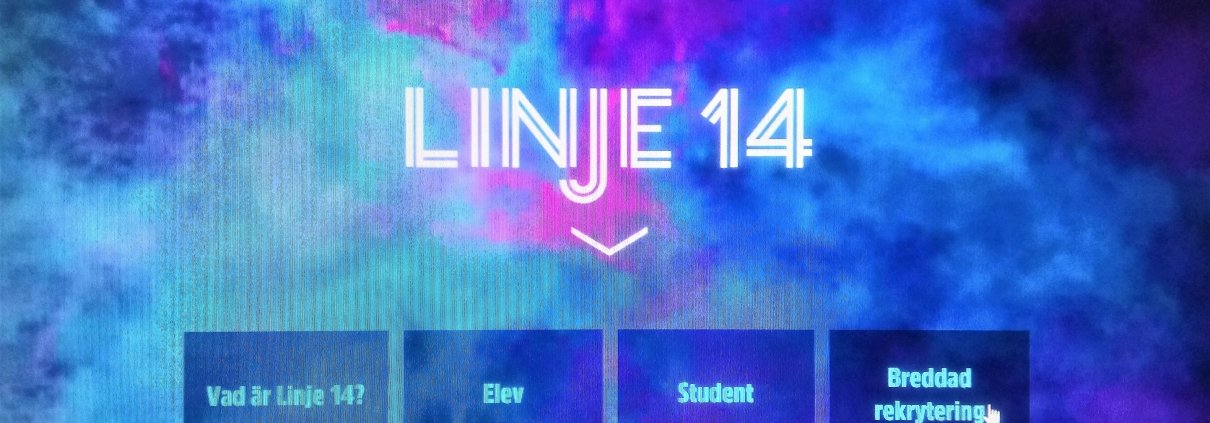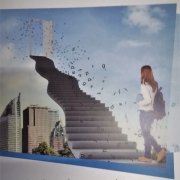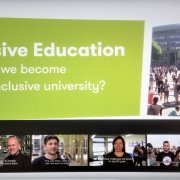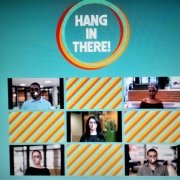Line 14
Excerpt
From Örebro University website:
Why 'Line 14'? This is the name of the bus route that used to run directly from the west of Örebro to the University - symbolising the life journey we aim to take our participants on.
‘Line 14’ (Linje 14 in Swedish) is a collaboration project between Örebro University and Örebro municipality that’s existed since 2003.
It encourages young people growing up in non-academic environments in the west of Örebro to study at university or college after high school.
Currently, the schools involved in the project are Vivallaskolan, Västra Engelbrektsskolan and Mellringeskolan.
Through a variety of activities such as homework, study skills courses, goal-setting days, field trips, mentoring projects and the Summer College at Örebro University, the project provides an opportunity for the pupils involved to meet representatives of Örebro University on a weekly basis. And in cooperation with school counselors, their parents are informed about the potential of upper secondary school and university.
In total, 50 students at Örebro University are actively engaged in the project, along with representatives from each of the University’s departments. In addition, the project includes six principals and 50 teachers from participating schools.
All this means that we can support approximately 600 young people each year.
The project is reviewed by an external quality assessment annually. And the results are positive, with improved transition of involved pupils into higher education. It’s a project with huge potential, and preliminary steps are underway for a larger research evaluation to inform and underpin a model that can be applied across Sweden and beyond.
Narrative, origins and objectives of the initiative
What kind of project is this? Please give a short description (summary) of it.
The aim of Line 14 (in Swedish, Linje 14) is to increase the numbers of young people from under-represented groups entering higher education. One important target group is children from lower income families.
Örebro University collaborates with nine schools, one library, a sports club and one recreation centre, offering activities where students from the university meet young people and talk about life as a student. The content of the activities varies and aims to give new perspectives. Study assistance is given weekly, workshops once per term and visits to campus. The project also offers the opportunity to attend summer college, where 25 young people get the chance to experience what it is like to be a student for three weeks.
Please tell us why, in general, this project is considered a successful one?
This project has been running since 2003. In 2014 the result of a statistical mapping (Trumberg, 2014) shows that there have been a number of changes regarding the transition to higher education for students from the Vivallaskolan during the surveyed period of time. Even though the students have relatively low merit points, one can see that the proportion of students seeking higher education at universities and colleges from Vivallaskolan is relatively large. Overall, there is a positive development where the proportion of students from the Vivallaskolan applying for college and university increased slightly between 2003 and 2008. The results for Vivallaskolan are compared with the results of a control school located in another municipality but in a similar residential area. The statistical analysis shows that the proportion of applicants for higher education from Vivallaskolan is greater than expected, i.e. the results should be more negative considering the general development of the area as well as the students’ socio-economic background. There is also a larger proportion of students from the Vivallaskolan applying to university and college than from the control school. This is despite the fact that both the control area and the control school students have a somewhat more favourable socio-economic structure. This means that students from the academic environment are more inclined to be looking for higher studies from the Vivallaskolan than from the control school. The comparison with the national average will be interpreted with caution since measurements are not directly comparable. However, the proportion of applicants for higher education in The Vivallaskolan is above the national average when comparing the proportion of students passing to higher education no later than three years after completing upper secondary school.
The proportion that studies or has studied in higher education is also greater for the Vivallaskolan than for the control school. In comparison with the control school it is shown that the percentage who studied during 2003 compared with 2008 has increased in Vivallaskolan, but decreased in the control school. In view of this, the result is interpreted as likely to be an effect of Linje 14. The project therefore has had a positive impact on students' inclination to apply for studies at colleges or universities.
And why would you consider it a grass-roots initiative?
The project was initiated by a teacher who, at the time, worked at the Vivallaskolan and operated it for 10 years. A number of officials have been involved in the project over the years and the expansion of recent years is a conscious strategy for spreading the project as a good example, thus easing the transition to higher education for the underrepresented target group.
What challenges needed to be solved in this project?
A higher education education is a protection factor against, for example, ill health and crime, but the most important thing is tertiary studies - a factor that improves individuals' chances in life (Dahlstedt et al., Olofsson). The interest in and knowledge of higher education among elementary school students is largely governed by the parents' educational background (UKÄ 2018), and therefore it becomes important to motivate and inform pupils about the opportunities HE studies enhance.
Is this initiative based on any particular theoretical framework? Which one?
A higher education is a protective factor against, for example, ill health and crime, but above all tertiary studies is an important factor that improves individuals' chances in life.
(Appendix) Is your intervention standing on its own or is it a part of a bigger and more holistic approach?
Under the Higher Education Act §5, universities should promote widening participation in higher education.
Please describe the group(s) intended as beneficiaries of this initiative
Why has this group (have these groups) been chosen?
The main target group—young people from lower socio-economic backgrounds—is an underrepresented group in Swedish higher education.
Could you please tell us something about the relative size of the (of each) target group, within the school/university population, region and/or country?
Örebro Municipality: 2500 pupils
Kalrskoga Municipality: 1500 pupils
Get ready: 100 pupils
Örebro University: 100 Student Ambassadors
Which social characteristics are taken into account and what is the geographical area covered?
The main target group are young people from lower socio-economic backgrounds.
On which level is the project implemented?
The highest political level in each municipality (Kommunstyrelsen), political board of education (Programnämnd barn och utbildning) as well as each school board (ledningsgrupper), university board.
Please describe the political and socio-economic factors that you believe have been important enablers for your initiative
Did the initiative have political support?
The initiative was originally from the Ministry of Education. The project still has political support.
How did it fit with local, regional or national policies?
The Örebro Region Development Strategy (RUS) will be a common guide to the region's future work. The aim is to create the best possible future for people living and working in the region. One goal is to increase the transition to higher education
Who are the stakeholders supporting the initiative?
Politicians; the Deputy Vice Chancellor of the university (responsible for first- and second-cycle courses and study programmes); heads of academic departments and programme coordinators (involved in student recruitment and widening participation).
Are there particular demographic changes present that are influencing the project?
A process of implementing the project to all municipalities in the Örerbro region has started.
What is the institutional strategy and culture of the (educational) organization?
The project is seen as an important work that makes a difference and happens in close cooperation with the surrounding community.
To what extent does the initiative have an influence on institutional policy (or potential influence) of the (educational) organization?
In the university’s new equality policy this initiative inspired to improve the work of reaching underrepresented groups, such as women in technical professions.
(Appendix) Is there public support for your initiative and the issue it addresses?
There is lots of public support. Young people attending the project and other effects are often seen in media.
(Appendix) What other factors do you think have been important for the success of this initiative?
Since the project has been running for a long period of time, one can also see that several students who met in elementary school are now studying in higher education. They often look up Line 14 and want to work as student ambassadors themselves for the purpose of “giving back”.
Please describe the overall initiative design and the methods and tools used to reach the goals
Please describe the specific activities carried out.
Linje 14 offers a wide range of activities in cooperation with schools throughout the academic year. The activities are designed according to a staircase model, where students take part in activities tailor-made to meet their needs. As a first step, the activities evolve around identifying the student ambassadors on a personal level in order for the ninth-graders to develop on a day-to-day basis at the university. The layout is designed and tested by educators and evaluated by students in grade nine annually.
Study assistance after school hours
Line 14 offers study assistance after school hours at the respective school, which is voluntary and takes place in cooperation with the school staff. Student ambassadors are scheduled who then tutor pupils in their school work. Study aids are arranged after school hours and never replace the help students in need of special support are entitled to receive from the school.
Study assistance during school hours
This activity is offered to schools within the framework of the pupil’s choice. Teachers are responsible for teaching and student ambassadors tutor the students in their school work. The purpose of the activity is to reach those volunteers who do not come to the field of study. During regular school days, they will instead have the option of additional support to reach approved grades or support in the work to get higher grades.
Workshops
During school hours, three different workshops will be held throughout the year, where activity coordinators and student ambassadors will give the lessons. The purpose of these workshops is to inspire, motivate and engage students.
When I was your age
In grade seven, each class meets student ambassadors who share their personal stories about education in order to motivate students to engage in their future. Students are encouraged to participate in Line 14's study assistance.
The art of being smart
In grade eight, students elaborate on study techniques and different learning strategies and to structure their duties. During the session, art is being discussed as a way for the pupils to set goals for themselves and to be content with their performance.
Future, education and opportunities
In conjunction with the upper secondary school, pupils will discuss and reason about how to know what they are good at, how they see themselves in ten years' time and where they want to be in life and in their careers. The starting point is that everyone has the opportunity to study further and realize what they want to accomplish.
Visits at campus
During the academic year, student visits are organized for grade nine students at Örebro University. The students participate in activities tailored to the target group and take part in a walking tour on campus. During the day, the ninth-graders will get an university experience and see what a regular day as a student can look like, and get the opportunity to ask questions about higher education.
Scholarships
Each year, on the last day of the school year, motivation grants are awarded to students who have worked purposefully during Line 14's study assistance opportunities and thus developed knowledgeably. It is Line 14's student ambassadors who nominate students and fellows are appointed in consultation with the respective school's management team. The scholarship does not impose any counterclaim on the student.
Meet with parents
Line 14 participates in parental meetings organized by schools to maintain good contact with parents of the young people involved in the business as well as to answer questions about higher education.
Lectures
On request, lectures and study visits are offered to interested individuals.
What were the key roles (teacher, student, management team etc.) within the project?
The university students are the key role players. Everyone studying at Örebro University has the opportunity to apply for the assignment as student ambassador for Linje 14 and the selection in recruiting is done through interviews. Those who are offered the assignment undergo training, where the role of student ambassador, the purpose of Line 14 and the school's governing documents and working methods are discussed.
The student ambassadors cover most areas of education at Örebro University as well as a majority of the languages spoken in Örebro Municipality. In 2019, the project plans to increase the number of ambassadors in the mathematical/natural sciences and artistic areas and to achieve a more even gender distribution.
What ideas, tools, theories, models, methodology (etc.) have been used to reach the goals?
The project focuses on creating meetings between students and pupils with the idea that creating relationships is an important factor. The students then act as positive role models that give young people a new perspective and convinces them that higher education is an opportunity.
What are the final revenues of the project?
That long-term strategic work does have an effect.
Please describe if your project ensured its sustainability
If so, how did you ensure the short-term impact of the project?
And how did you ensure the long-term impact of the project?
The project has been running for 15 years and, according to the agreement, will continue for at least 2 more years.
Has your project been replicated elsewhere?
Karlskoga Municipality.
Please tell us about the resources used in this initiative
What was the budget for the initiative?
1 Project Manager
3 Coordinators
2003 500 000 SEK
2006 1 000 000 SEK
2014 1 750 000 SEK
2018 2 250 000 SEK (Örebro) 1 500 000 (Karlskoga)
100 Student Ambassadors
How much did the initiative depend on volunteers?
Student ambassadors work about 4000 hours per year. They get a small salary, 115 SEK per hour. Usually they work 2 hours per week. That barely covers the cost of their transport.
How were the costs perceived by the public/the sector/other stakeholders?
That it was a political decision.
To what extent did the initiative achieve its objectives?
Please describe the evidence to support the success of your initiative.
Pupils attending Linje 14 are far more likely to attend university after completing school.
Did the intervention lead to any unintended (positive) outcomes?
What indicators (quantitative and qualitative) have you measured to demonstrate success?
The report analyses data from Statistics Sweden (SCB) and available public statistics with focus to chart how the transition to higher education appears in the Vivallaskolan in 2002-2012. The results of the study show that there have been a number of changes regarding the transition to higher education for students from the Vivallaskolan during the surveyed period of time. Even though the students have relatively low merit points, one can see that the proportion of students seeking higher education at universities and colleges from Vivallaskolan is relatively large. Overall, there is a positive development where the proportion of students from the Vivallaskolan as applying for college and university increases slightly between the years 2003 and 2008. As mentioned, the results for Vivallaskolan are compared with the result of a control school located in another municipality but in a similar residential area.
For research methods and results, see Narrative, origins and objectives of the initiative—Please tell us why, in general, this project is considered a successful one, above.
(Appendix) How did you evaluate/monitor this intervention?
The project increases every year by an external part.
A report Trumberg, A; Lindberg, D “Övergång till högre utbildning-en statsitisk kartläggning av Linje 14”


 Copyright by Mili Flener
Copyright by Mili Flener




